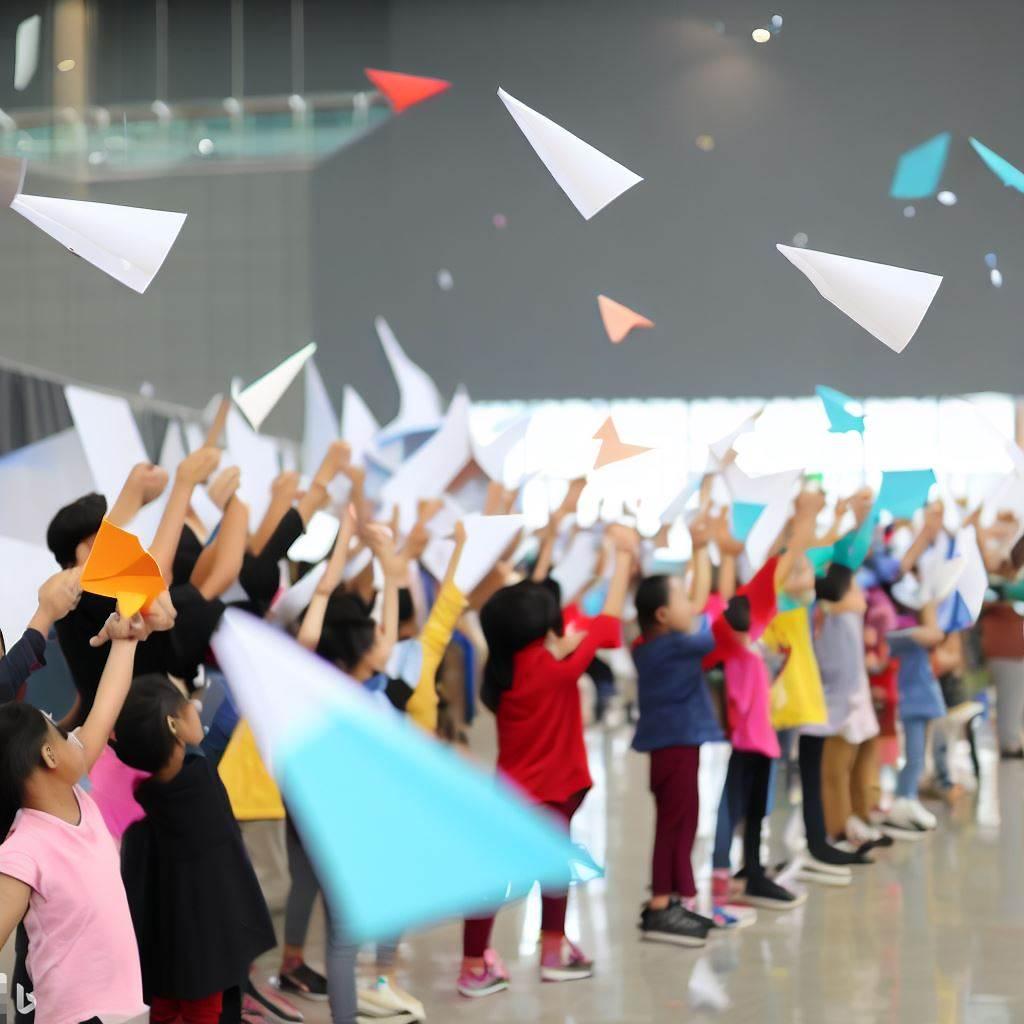In today’s digital age, sometimes it’s fun to take a step back and enjoy the simple things in life. The Paper Plane Parade has been popular for generations making and flying paper planes. But why keep this fun to ourselves? Hosting a paper plane parade is a fun and engaging way to bring people together and enjoy the thrill of flying paper planes. In this article, we’ll explore how to host a paper plane parade and create an unforgettable experience for all involved.
Materials
The materials for a paper plane parade are simple and easy to obtain. You’ll need:
- A large open space such as a park or field. Alternatively, a higher starting point like a balcony
- A variety of paper (colored or patterned paper works best for visibility)
- Scissors, glue, and tape
- Markers or other decorating materials
- Prizes for the winners
Preparation
What is needed for thr paper plane parade team building activity? To prepare for a paper plane parade, start by getting a variety of papers. Different sizes and colors will make the event more funny and creative. As a next step you should find some instructions for building paper planes. Get the materials to from the list above to build different designs. Make sure to create planes of different sizes and shapes to add to the fun.
Next, decide on the rules for the parade. You can choose to have a competition with different categories, such as distance or design. Or, you can let everyone fly their planes and enjoy the experience.
Finally, ensure you have plenty of open space for flying the planes. Choose a location with minimal obstacles and a large enough space for everyone to fly their planes without colliding.
Run the Paper Plane Parade
Set up a designated area for people to decorate their planes. This is a fun activity that can be enjoyed by everyone. Once the preparation and decoration of the planes is finished, it’s time to start the parade!
To begin, have everyone stand at a designated starting point. On the count of three, everyone will throw their planes and watch them soar through the air. It’s a great idea to have someone on hand to measure the distance each plane travels to determine the winners.
After the competition, give out prizes for different categories or simply enjoy watching the planes fly. You can even have a special prize for the most creative plane design.


What are the benefits of a Paper Plane Parade?
A “Paper Plane Parade” is not a commonly known or established term or activity, so I’ll provide some benefits of organizing and participating in a paper airplane-related event or contest. Paper airplane activities can be fun and educational, making them suitable for various occasions, including team-building events, school projects, or recreational gatherings. Here are some benefits:
- Creativity and Design Skills: Organizing a paper airplane parade encourages participants to use their creativity and design skills to construct unique and innovative paper airplanes. This process fosters imaginative thinking and problem-solving.
- Hands-On Learning: Building and testing paper airplanes is a hands-on learning experience that can be both entertaining and educational. Participants learn about aerodynamics, physics, and engineering principles while having fun.
- Competition and Sportsmanship: Paper airplane contests or parades often involve friendly competition. Participants can develop sportsmanship, learn to handle both success and failure gracefully, and appreciate the value of fair play.
- Team Collaboration: In team-building contexts, paper airplane activities can promote collaboration and teamwork. Teams work together to design, build, and test their airplanes, fostering communication and cooperation among members.
- STEM Education: Paper airplane activities align with STEM (Science, Technology, Engineering, and Mathematics) education principles. They can be used as engaging tools to teach these subjects in a practical and enjoyable way.
- Fine Motor Skills: Folding and assembling paper airplanes require fine motor skills. Engaging in such activities can help improve manual dexterity and coordination, particularly in younger participants.
- Problem-Solving: Participants encounter various challenges when designing and flying paper airplanes. They must troubleshoot and make adjustments, promoting problem-solving skills and adaptability.
- Entertainment and Relaxation: Paper airplane parades can be a source of simple entertainment and relaxation. They offer a break from routine activities and provide a lighthearted way to unwind and have fun.
- Inexpensive and Accessible: Paper airplane activities are low-cost and accessible to people of all ages and backgrounds. All that’s needed is a sheet of paper, making it an inclusive and budget-friendly pastime.
- Community Building: Organizing paper airplane events can bring people together and foster a sense of community. It provides an opportunity for social interaction and bonding.
- Environmental Awareness: While paper airplanes are made from paper, they can also serve as a starting point for discussions on sustainability and recycling. Encouraging responsible disposal of paper and recycling can be incorporated into the activity.
- Inspiration for Aviation Careers: Participation in paper airplane activities can spark an interest in aviation and aerospace careers, inspiring future engineers, pilots, or scientists.
- Record-Setting Opportunities: Some paper airplane events involve attempts to break distance or flight duration records. This can add an element of excitement and motivation for participants.
In summary, paper airplane activities, whether in the form of contests, parades, or educational projects, offer a range of benefits, including fostering creativity, teamwork, learning opportunities, and entertainment for participants of all ages.
Debrief
After the paper plane parade is over, it’s a great idea to debrief with everyone involved. This is a chance to reflect on the experience and discuss what went well and what could be improved for next time. Here are a few questions to consider during the debrief:
- What was your favorite part of the paper plane parade?
- Did you enjoy making paper planes or flying them more?
- What do you think could be improved for next time?
- Would you participate in a paper plane parade again in the future?
The debrief is also a great opportunity to thank everyone for coming and for their participation. If you took pictures or videos of the parade, be sure to share them with everyone as a fun reminder of the experience.
Conclusion
In conclusion, a paper plane parade is a simple yet enjoyable way to bring people together and have some fun. With a little preparation and a large open space, you can create an unforgettable experience for everyone involved. By following the steps outlined in this article, you can organize a successful and memorable event. Remember to have fun, be creative, and enjoy the experience!


